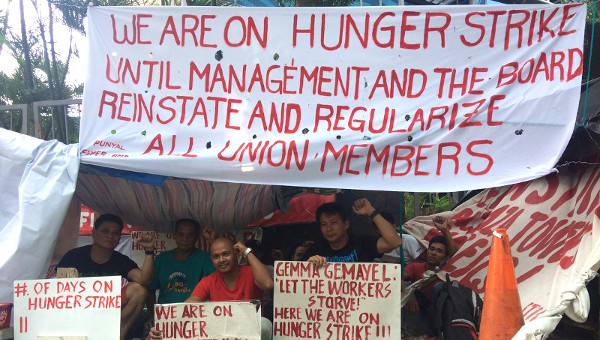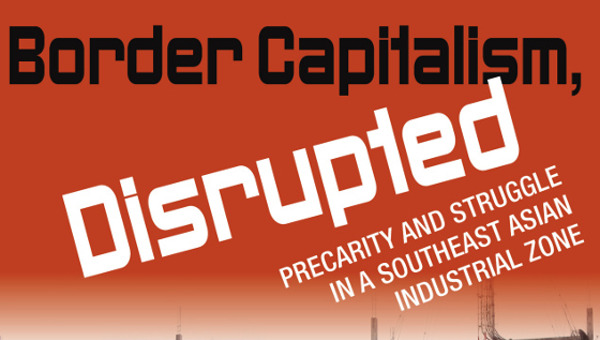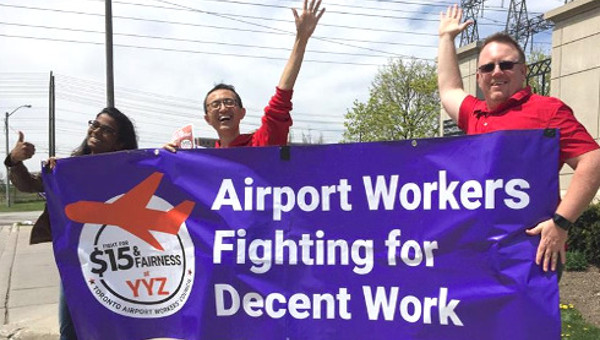A Compendium of Forms and Preliminary Discussion
While labour migration has been a recurring phenomenon in human history, what is new in the post-1970 period of restructuring in the world capitalist economy is the increased use of temporary migrant labour by employers around the world. The widespread rise of employer use of temporary migrant workers in various economic sectors internationally can be dated from circa 1990. As I argue at length elsewhere, the increased use of temporary migrant labour may be viewed as a more recent strategy of employers and states to shift power away from workers and unions following from the successes of worker and union power in both the global North and South circa 1950 to 1980 (Valiani: 2012; Valiani: 2013b).
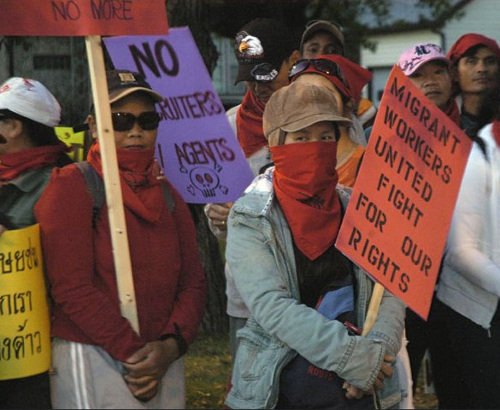
temporary labour migration have presented considerable organizing challenges, and this has led to a variety of types of responses. As responses, all of these forms are predominantly reactive in nature – thus comprehensive, transnational organizing strategies have yet to emerge. Comprehensive organizing strategies involve not only assisting temporary migrant workers to resolve day-to-day wage, benefit, and health and safety issues, but reformulating collective bargaining to circumvent employer undercutting of gains made by unions through the employment of temporary migrant workers. Only through further engagement in the forms of organizing presented here, and the collective learning entailed therein, will such strategies emerge.
Temporary Labour Migration as a Specific Labour Form
Temporary labour migration is the phenomenon of workers migrating on the basis of temporary work authorizations which attach the legal status of workers to particular employers or/and particular positions of employment. Temporary labour migration schemes take on various forms: from bilateral and regional agreements for the exchange of labour between states, to changes in national legislation allowing employers easy and accelerated access to temporary migrant workers for varying time periods, to provisions in multilateral trade agreements such as Mode IV of the World Trade Organization’s General Agreement on Trade in Services.
Temporary labour migration on the basis of temporary work authorizations, or work permits, contrasts with permanent migration and the accompanying legal status of permanent residency. In countries such as Canada, Australia, the United States of America, Britain, and Singapore, permanent residency involves the right to settle for all internationally-trained workers, including full legal protections, the right to live and work in the location of one’s choice, the right to family reunification, and a path to citizenship and voting rights. In that internationally-trained workers entering countries as permanent residents are entitled to virtually the same social, economic, and political rights as those already possessing citizenship, they become part of national labour markets. Temporary migrant workers, on the other hand, earn wages in countries of employment while transferring a significant proportion of them to family members in home countries. As such, temporary migrant workers constitute the integrating links between labour markets of home and destination countries without enjoying full belonging in any of them (Valiani: 2013a). The shift from permanent residency to temporary labour migration as the major means of entry for internationally trained workers to countries of the global North began unfolding in the early 1990s. Through temporary migration, states of source countries of migrant workers are assured a flow of foreign exchange via the funds remitted home by workers to support families. Employers and states of destination countries benefit from a malleable, ever flexible form of labour while keeping to a minimum the social and economic costs of employment and settlement.
Given that the legal status of temporary migrant workers is bound to employers and the sanction of deportation contained within, protection of the rights of temporary migrant workers is at best unclear, at worst non-existent. Temporary legal status of workers, bound to employers, translates into an inordinate degree of power in employer’s hands within the generally uneven power relationship between individual workers and employers. Due to the particular need of temporary migrant workers to remain employed – to maintain legal status within the country of employment, to transfer remittances home, and to pay recruitment agency fees, which tend to be necessary to obtain employment away from home countries – employers may control to their advantage the terms of employment of migrant workers in ways they cannot vis-à-vis non-migrant workers.
As a result of these and other complexities, the mobilization of temporary migrant workers into a political force has taken various forms in the late twentieth and early twenty-first centuries. These forms are explored below along a continuum ranging from the promotion of migrant workers’ rights by well-intentioned activists, to migrant worker-led organizing initiatives.
Frontline Activism Promoting Workers’ Rights
The mobilization of temporary migrant farm workers in Ontario, Canada, by Justicia for Migrant Workers (J4MW), is an instance of this form of organizing migrant workers. J4MW, a self-funded collective of young, racialized activists, is engaged in rights education with migrant farm workers employed in Southern Ontario, assisting migrant workers to solve employment and housing problems, lobbying for legislative change, and public actions such as marches and protests where migrant workers are willing to take the risks involved. [Ed.: see LeftStreamed No. 197]
Defining themselves as “allies” of migrant workers and striving for “a movement that is led and directed by workers themselves” (Justicia for Migrant Workers: 2011), J4MW members negotiate a fine balance between utilizing their knowledge of labour and other state laws to benefit migrant workers, and remaining open to migrant workers’ needs and visions and allow them to be partners in devising
strategies for action. This balance is challenging in most national contexts given the disproportionate power carried by activists or advocates vis-à-vis migrant workers, whereby activists tend to be documented residents with full legal entitlements while migrant workers have minimal legal protection given their temporary legal status tied to employers.
As a result of its frontline engagement with migrant farm workers, J4MW was the key force that propelled the trade union, United Food and Commercial Workers of Canada (UFCW), into servicing migrant farm workers in Ontario. Following investigative missions of a migrant worker wildcat strike by activists who later formed J4MW, the UFCW opened its first migrant worker support centre in Southern Ontario in 2002. The centre employed some of the same J4MW activists involved in the investigative missions. Though having reached out to migrant farm workers in Ontario for the purpose of unionization and collective bargaining in 1994-1995, this UFCW activity was stopped short with the 1995 repeal of the law allowing farm workers to bargain collectively by a newly-elected right wing government (UFCW Canada: 2011). Though continuing its engagement in legal battles to regain the right to collective bargaining for farm workers in Ontario, by 2011, the UFCW was running four support centres for migrant farm workers in Ontario.
J4MW presents other political challenges to the UFCW and other trade unions around migrant worker issues. For instance, the J4MW demand for regularization, or the right to permanent resident status for all migrant workers entering Canada on temporary work permits is a demand which has not been adopted by all unions in Canada. As the rights of growing numbers of migrant workers are violated by employers in Canada, and as unionization of migrant workers leads to more deportations of migrant workers, unions may well be forced to accept that the principal policy solution is the right to permanent resident status for all workers whose labour is required in the Canadian economy. Among other things, the right to permanent resident status in Canada allows workers to change employers, a key human right not enjoyed by temporary migrant workers. With this constraint on migrant worker mobility, employers are able to exercise particular liberties over migrant workers including violation of contractual agreements and labour legislation. Where temporary migrant workers do attempt to claim their rights, termination by employers leading to deportation by the state is typical.
International Union Collaboration
In 2000, the U.S.-Jordan Free Trade Agreement (FTA) was signed by the governments of the United States of America and Jordan. The intensification of labour violations resulting from this agreement lead to international union collaboration around the servicing and organizing of migrant workers.
In greater detail, though lauded for its inclusion of a “Labour Chapter” detailing labour rights, the U.S.-Jordan FTA led to the increased use and abuse of temporary migrant workers in Jordan. Due to the exclusion of migrant workers from the right to unionize under Jordanian labour law, the requirements of the Labour Chapter – to abide by ILO core labour standards and enforce Jordanian labour law – did not apply to migrant workers in Jordan. As more U.S. markets were opened to Jordanian goods under the FTA, employers in Jordan increased their use of temporary migrant workers to expand production and avoid the “added costs” of hiring Jordanian workers whose rights had come under the protection of the FTA and its Labour Chapter (Al-Omrani: 2008).
Shortly thereafter, in realizing the shortcoming in its support for the U.S.-Jordan FTA due to the inclusion of a Labour Chapter, the American Federation of Labour and Congress of Industrial Organizations (AFL-CIO) created a partnership with the General Trade Union for the Textile Industry in Jordan to begin to rectify the situation. This partnership involved devising a strategy to reach-out to the 36,000 migrant workers in the Qualified Industrial Zones, which came into being following the 2000 signing of the FTA (Al-Omrani: 2008). The AFL-CIO provided funds to the General Trade Union for the Textile Industry to hire organizers to make contact with migrant workers in their languages of origin, and document cases of rights violations. By 2006, this work contributed to the joint-filing of a complaint by the AFL-CIO and U.S.-based National Textile Association under the U.S.-Jordan FTA Labor Chapter (AFL-CIO: 2006).
Inclusive Sectoral-Based Unionization
In 1974, FILCAMS-CGIL negotiated the first National Collective Bargaining Agreement on behalf of the estimated 1.3 million domestic household workers in Italy. About 80 per cent of these workers are migrants, about 90 per cent are women, and not all are documented migrant workers. The agreement covers both documented and undocumented migrant domestic household workers, whether they are union members or not, in addition to domestic workers who are Italian nationals (European Trade Union Confederation: 2005).
Previous to 1974, regulations recognizing some rights of domestic household workers had existed in Italy. The right to holiday pay was recognized in 1958, the right to health protection during pregnancy in 1973, and rights to social security protection and old age benefits in 1973. With the National Collective Bargaining Agreement of 1974, wage levels came to be negotiated on a yearly basis. Other provisions covered by the agreement since 1974 include: the right to sick pay, the right to overtime pay, a thirteenth month bonus, protection against dismissal during pregnancy, and the right to accumulate holidays over extended periods to facilitate visits to distant home countries (European Trade Union Confederation: 2005).
Some of the later targets of collective bargaining included: greater recognition of the value of domestic work through the reduction of the work week and increased remuneration, 40 hours of training per year with a joint labour-employer body to oversee training, and health care including mental health support (European Trade Union Confederation: 2005).
Facilitating FILCAMS-CGIL and other unions involved in organizing domestic workers in Italy is the fact that the National Collective Bargaining Agreement is recognized by the Ministry of Labour, making it part of federal collective labour law. The Agreement is negotiated by unions representing domestic workers and two national federations of private householders employing domestic workers. This in turn means that in theory as well as in practice, the Agreement is recognized and respected by individual employers of household domestic workers (European Trade Union Confederation: 2005).
Temporary Migrant Workers Self-Organizing Internationally
Migrante International (MI) is the example par excellence of this form of self-organizing by migrant workers. MI is the international alliance of Filipino migrant organizations, thus the umbrella organization of migrant workers originating in the Philippines and employed around the world. As the world’s largest, official, labour-exporting country, the Philippines “exported” 1,422,586 temporary migrant workers to 182 countries in 2009 (Philippines Overseas Employment Administration: 2010; Migrante International: 2011a). In addition to monitoring policies of the Philippines and other governments around temporary migration, MI offers counselling, shelter, welfare, and paralegal services to Filipino migrant workers employed in various economic sectors.
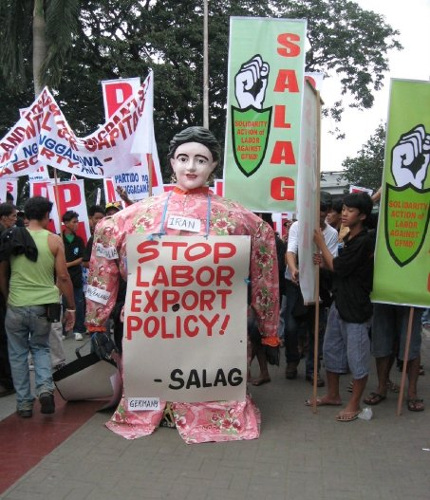
MI and its member organizations stage a variety of campaigns ranging from targeted advocacy to mobilizing around broad policy demands. For example, in 2009, Migrante advocated for the rights of 10 migrant workers in Taiwan caught in a labour trafficking scheme denounced by the Taiwan National Immigration Agency but overlooked by the Philippines labour attaché in Taipei (Migrante International: 2009). In 2008, Migrante Hong Kong and Migrante Middle East staged actions to protest the Philippines government’s attempt to ban Filipino migrants from joining unions in their countries of employment (Migrante International: 2008). In 2011, Migrante Middle East called for the Philippines Embassy in Tripoli to assume full responsibility for the safe repatriation of Filipinos employed in Libya during the civil political conflict (Migrante International: 2011b).
In 2008, MI helped establish the International Migrants Alliance, a global coalition of migrant-led organizations which tends to assemble around inter-governmental gatherings such as the Global Forum on Migration and Development.
Collaboration Between Migrant-Led Organizations and Unions
The Asian Migrants Coordinating Body (AMCB) is a coalition of migrant worker led organizations in Hong Kong. Organizations composing the AMCB represent migrant workers from Indonesia, Nepal, Philippines, Sri Lanka and Thailand employed in Hong Kong, primarily in the domestic care sector. The AMCB began in 1994 as a gathering of migrant workers of different origins for the purpose of inter-cultural exchange and increased understanding between workers (Bultron: 2006).
In 1998, when the Hong Kong government announced a reduction of the minimum wage of migrant domestic workers, the AMCB used its mobilizing skills to confront its first political issue (Bultron: 2006). The AMCB collaborated with the Hong Kong Council of Trade Unions to mobilize workers to oppose government legislation to reduce the minimum wage of migrant domestic workers numbering in the late 1990s at over 150,000 (Briones: 2009, 73; Migration News: 1998). The two labour-centred umbrella organizations organized mass mobilizations of workers of various sectors to protest a fall in wages of the lowest paid migrant workers in Hong Kong. This collaboration resulted in a partial victory in 1999, whereby the minimum wage of migrant domestic workers was reduced by 5 per cent rather than the proposed 20 to 25 per cent (Briones: 2009, 74).
Temporary Migrants Self-Organizing and Affiliating to National Labour Federations
The Migrants Trade Union is arguably the most far reaching example of self-organizing by migrant workers in the world today. In 2005, undocumented migrant workers in South Korea formed the Seoul-Gyeonggi-Incheon Migrants Trade Union (MTU), bringing together documented and undocumented temporary migrant workers from over 20 different countries (Liem: 2008; Wang-Bae: 2004). The MTU was born primarily of the desire of migrant workers for self-determination within a political context of migrant rights advocacy led by nongovernmental organizations and religious groups based in South Korea. Tensions between migrant workers and local activists surfaced during a 13 month sit-in by the two sets of actors at the historic Meyeong-dong Cathedral in downtown Seoul, in 2003-2004 (Liem: 2008). Though the joint-action of local activists and the Migrants Branch of the Equality Trade Union – predecessor of the MTU – was successful in raising public awareness around rights violations and deportations of migrant workers, the Migrants Branch members emerged from the action with clarity around the need to form an independent trade union for migrant workers. At the time of its formation in April 2005, the MTU became a member of the Seoul Regional Council of the Korean Confederation of Trade Unions (KCTU).
Since 1994, temporary migrant workers under various pieces of legislation have not been afforded the full protections of labour laws of South Korea. As a result of this, migrant workers face abuses including unpaid wages, unsafe working conditions, and confiscation of passports by employers. As in other countries, to extricate themselves from such conditions, workers tend to leave their legal employers thereby becoming undocumented workers (Liem: 2008; Wang-Bae: 2004). As a result of this, approximately one half of the 400,000 temporary migrant workers in South Korea were undocumented by the time of the formation of the MTU (Joo Bong Hee: 2008). It was on this basis that the South Korea Ministry of Labour refused to recognize the MTU in 2005. The Ministry argued that due to the undocumented status of a portion of the MTU’s elected leaders and members, the MTU did not merit legal recognition. The MTU and KCTU contested the Ministry’s position, arguing that status under immigration law is unrelated to “worker status” under the Korean Constitution and Trade Union Law, particularly where migrants are in an employment relationship with South Korean employers (Liem: 2008). In February 2007, the Seoul High Court upheld the argument of the MTU/KCTU, thereby recognizing the MTU as a union. Shortly thereafter, the Ministry of Labour appealed the ruling of the Seoul High Court.
Shifting to a law and order strategy, the Korean state arrested the MTU second President Khapung, Vice President Gurung, and General Secretary Moniruzzaman under the Immigration and Control Law, deporting the three leaders in November 2007. The same approach was used in April 2008 to arrest, detain, and deport the newly elected MTU President Torna and Vice-President Sabur (Liem: 2008). At the time of writing, the Supreme Court had still not ruled on whether it would uphold the decision of the Seoul High Court to recognize the legal status of the MTU.
Preliminary Discussion
Clearly the examples used here to illustrate various forms of organizing are the outcomes of specific historical circumstances – for instance, the particular economic sectors, working conditions, labour union histories, or/and make-up of migrant worker populations in question. As I demonstrate elsewhere for nursing labour markets, sector-specific analysis is crucial to develop an understanding of the varying reasons and timings for increased employer use of temporary migrant labour in different economic sectors and labour markets (Valiani: 2012). From such sector-specific analyses, along with continued engagement in the various forms of organizing exemplified here, viable, appropriately transnational labour organizing and collective bargaining strategies may be devised. Given the relatively recent shift to substantial use of migrant labour in most economic sectors, and in turn, the rather early phase of migrant worker organizing currently unfolding, only a preliminary analysis is attempted here.
In an article entitled “Beyond Social Unionism: Farm Workers in Ontario and Some Lessons from Labour History,” Butovsky and Smith (2007) underline the inadequacy of the “legalistic and legislative strategy” of unions and activists struggling with migrant farm workers in Canada. Included here are both the UFCW and Justicia, which Butovsky and Smith criticize for employing tactics such as “court challenges, moral suasion, and public education” which accept as “a given the permanence of capitalist exploitation,” (Butovsky and Smith: 2007, 70).
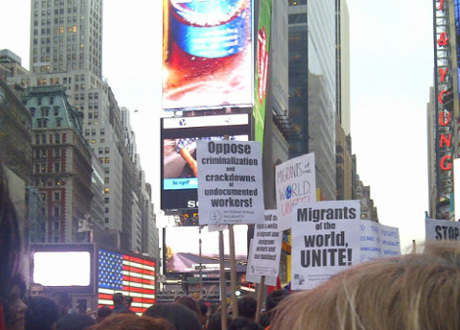
Instead of these tactics, Butovsky and Smith argue for “direct struggles” of workers “against capital and the capitalist state,” (Butovsky and Smith: 2007, 70). Drawing “lessons” from farm workers’ struggles in California from 1950 to 1970, Butovsky and Smith make three key prescriptions: that unions and activists demand full citizenship rights for past and current temporary migrant farm workers in Canada while calling for the abolition of the Seasonal
Agricultural Workers Program (SAWP, the program allowing farm employers access to temporary migrant workers); that the pursuit of pro-labour legislation is to “abdicate the fight for farm workers’ rights before it even really begins”; and that “labour solidarity”, or unity between workers of all industries and beyond nationality is fundamental (Butovsky and Smith: 2007, 93).
Rather than Butovsky and Smith’s stark juxtapositioning of legalistic-legislative strategy versus class struggle based strategy, Samir Amin’s (2012) notion of acting for “radical reforms in stages” is more useful in the post-1980 context. More specifically, since 1990, over and above formal labour migration programs, employers have benefitted from near endless supplies of migrant workers (i.e. undocumented migrant workers) resulting from 30 years of neoliberal capitalist development involving jobless growth and increased unemployment globally. Justicia’s long standing demand and public campaigning for immediate permanent residency and full citizenship rights for past, present and future migrant [farm] workers – essentially the opposite of demanding abolishment of the SAWP – is a radical reform proposal which not only grapples with the current realities of workers and labour supply, but also changes public and union consciousness around migrant workers’ rights. This strategic demand by Justicia is likely what led to the inclusion of permanent residency for migrant workers in collective agreements bargained by UFCW locals in the meat packing industry in Manitoba (Local 1118) and Alberta (Local 832). In greater detail, in provinces where employers can nominate temporary migrants for permanent resident status through ‘provincial nominee programs,’ the UFCW has pushed employers to do so by including such nominations as part of the terms of employing temporary migrant meat packing workers.
This dialectic between Justicia’s strategic demand and public campaigning for radical reform (i.e. immediate permanent residency), and strategic inclusion of the demand in UFCW collective bargaining processes illustrates the relation between different forms of migrant worker organizing today – all of which are important and necessary. While perhaps not the direct worker action that Butovsky, Smith and others would like to see, the range of tactics – varying in their degree of confrontation to capital and the capitalist state – are crucial in a socio-political context where temporary migrant workers risk deportation merely by speaking against injustices or joining unions.
Similarly, though not militant, direct worker action, the use of collective bargaining by FILCAMS-CGIL and its migrant worker members (documented and undocumented) to secure the basic employment rights afforded to locally-based domestic workers is the first step to empowering a set of extremely superexploited workers who may then move closer to envisioning and engaging in direct workplace battles.
Finally, though still not legally recognized, the move to form the Migrants’ Trade Union and seek legal status (a pro-worker legislative change seen as an abdication of rights by Butovsky and Smith) was a major advance in that it made visible a significantly sized group of invisible, superexploited workers in South Korea. In moving to visibility, undocumented and documented migrant workers began erecting political limits on the employer abuse structured into immigration and labour laws little known to the public and many elected officials in South Korea. While far from the power of collective bargaining or strike action, in forming an independent union, MTU leaders and members experienced a previously unknown degree of collective empowerment, including by breaking from dependence on the charity of religious and nongovernmental organizations and joining forces with local workers through affiliation with the Korean Confederation of Trade Unions.
Conclusion
As demonstrated in these varying forms of migrant worker organizing, migrant workers and their allies face a range of complicated legal, political, and socio-economic challenges. Given this, it is both impressive and heartening that so many forms of organizing are being attempted to pursue workers’ rights within a global climate of state-sanctioned, deepening employer control. Critical for the building toward comprehensive, long-term transnational organizing and bargaining strategies is the collective learning emerging from the overlap and tension between different tactics and organizing forms. Workers, community activists and unions are all vital players, but without a major role played by unions – with their substantial financial resources, structural capacity, and institutional history – strategies to protect migrant workers’ rights, and by extension, workers’ rights broadly, are unlikely to expand to a scale proportional to the ever-increasing employer use of temporary migrant workers internationally. •



